Knee Extension – Why It’s So Important After ACL Surgery
By Guest Blogger Lauren Calamari, PT, DPT
The early days of rehab after ACL surgery are not glamorous. However, they are vitally important for setting up long-term success. Regaining knee range of motion is one of the first post-operative goals. While knee flexion (bending) is important, regaining knee extension (straightening) early on is a key factor for successful recovery. In fact, research shows us that failing to do so can put you at risk for negative long-term outcomes1,2,3. It is important to note that not all surgeries are the same, and many people have additional injuries that are also addressed during surgery. This can change the overall post-operative precautions, including range of motion, so always consult with your surgeon and/or physical therapist about what is best for your knee.
Achieving terminal knee extension (getting all the way to your knees end range of straightening motion) is important for several reasons. It is necessary to have a normal gait (walking) pattern once you can begin walking. It can also help to reduce post-operative swelling. Reducing swelling and attaining full extension allows your quadriceps (thigh) muscles to activate properly. In fact, swelling can “shut down” or inhibit the muscles surrounding your knee. This is called quad inhibition. In turn, quad inhibition will make it harder to diminish lingering swelling. You can see how this can become a vicious cycle! The bottom line is, regaining terminal knee extension as quickly as possible will help lessen these early challenges. Early quad activation will allow you to strengthen your quads adequately as you advance through your rehab process. Sufficient quad strength is essential for a safe return to your prior activity, no matter what that is. Strong quads give your knee stability and can help prevent secondary knee pain as you progress.
You can see why emphasizing knee extension early on is so important! Unfortunately, the first days and weeks following surgery can be exhausting and overwhelming, which can make accomplishing this goal tough. People often feel compelled to rest with their knee slightly bent or sit with a pillow under their knee. While this is more comfortable, it will make knee extension more difficult. During this time, it is easier to focus on a few simple tasks vs. a long list of exercises. So, here are a few simple extension exercises to focus on, which most people can perform right away:
- Heel Prop: Sit with your leg out in front of you and prop your heel on an elevated surface (this could be pillows, the arm of the couch, or the coffee table). Make sure only your heel is on the propped surface and there is space underneath your knee for it to fully straighten – the more elevated your leg is, the better (elevation also helps decrease swelling). Try to relax and let gravity push your knee down.
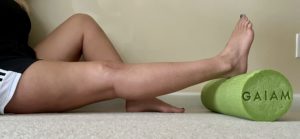
Try to tolerate this a couple minutes at a time. Over time, work up to 10 minutes of propping, 5 times per day.
- (Assisted) Heel Pop: Not to be confused with the heel prop. This will help with end range extension and quad activation. Sit with your leg out in front of you on a firm, flat surface. Loop a non-stretchy strap (dog leash, towel, fitted sheet will work) around the bottom of your foot. Gently pull on the strap to lift your heel off the ground while trying to squeeze your quad and push your knee down.
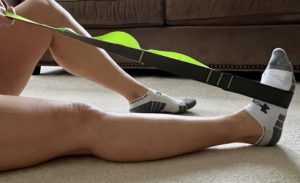
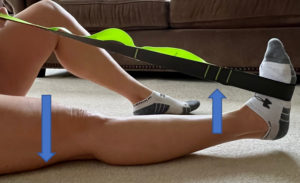
You might have to work up to these. Try 10+ squeezes at a time, holding each squeeze/heel pop for at least 5 seconds. Once able, do this several times per day following the heel prop.
- Quad Set: Sit on a flat, firm surface with your leg out in front of you. Squeeze your quad while trying to push the back of your knee down toward the surface. This addresses quad activation, which can be very challenging at first. Sometimes it helps to practice on your other leg!
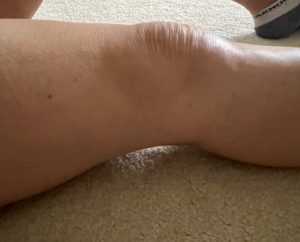
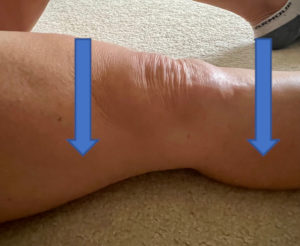
Try 20+ squeezes at a time, holding each squeeze for at least 3 seconds. It is good to do this right after you finish the heel prop & heel pop.
Performing these exercises is an excellent way to work toward achieving full knee extension after ACL surgery. I encourage everyone to work with a trusted, experienced physical therapist throughout their recovery process, and always consult their surgeon before performing any independent exercise. However, doing these on your own as part of a home exercise program will be an important part of the early rehab process, and will ultimately set you up for long-term success!
Disclaimer: Please consult your physician or health professional before engaging in any physical activity and stop if you experience pain or discomfort.
About Lauren Calamari, PT, DPT

Lauren graduated from the Medical University of South Carolina with her Doctor of Physical Therapy. She earned her undergraduate degree in Exercise and Sport Science from the University of North Carolina at Chapel Hill. She has experience treating middle school, high school, and college athletes, as well as active adults of all ages. Lauren currently works in an outpatient physical therapy clinic specializing in sports-specific treatment in Baltimore, MD. Her other professional interests include writing, education, coaching, and management.
Sources:
- Delaloye JR, Murar J, Sánchez MG, et al. How to Rapidly Abolish Knee Extension Deficit After Injury or Surgery: A Practice-Changing Video Pearl From the Scientific Anterior Cruciate Ligament Network International (SANTI) Study Group. Arthrosc Tech. 2018;7(6):e601-e605. Published 2018 May 7. doi:10.1016/j.eats.2018.02.006
- Delaloye J-R, Murar J, Vieira TD, et al. Knee Extension Deficit in the Early Postoperative Period Predisposes to Cyclops Syndrome After Anterior Cruciate Ligament Reconstruction: A Risk Factor Analysis in 3633 Patients From the SANTI Study Group Database. The American Journal of Sports Medicine. 2020;48(3):565-572. doi:10.1177/0363546519897064
- Shelbourne KD, Gray T. Minimum 10-year results after anterior cruciate ligament reconstruction: how the loss of normal knee motion compounds other factors related to the development of osteoarthritis after surgery. Am J Sports Med. 2009;37(3):471-480. doi:10.1177/0363546508326709
Categories
-
Recent Posts